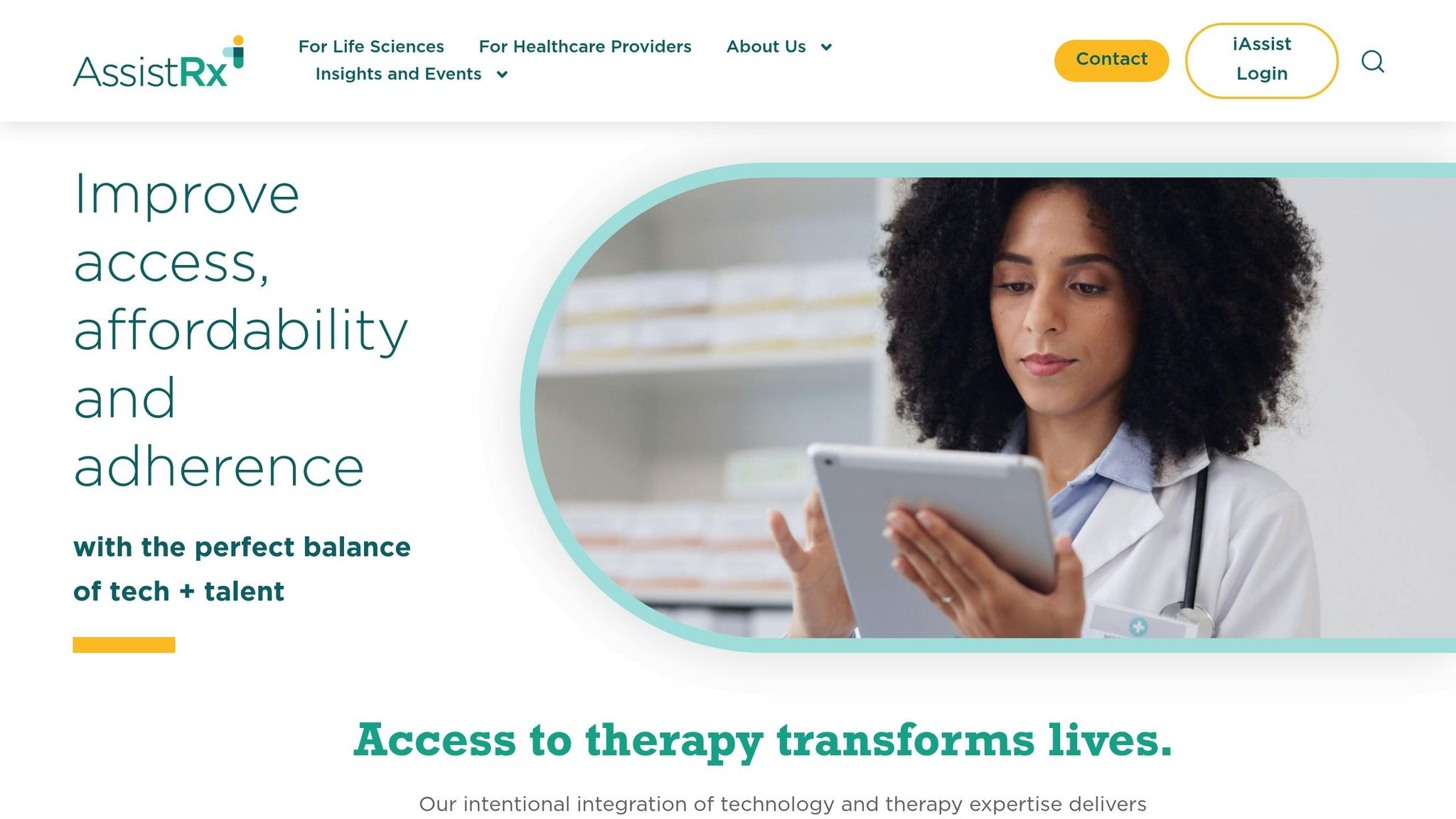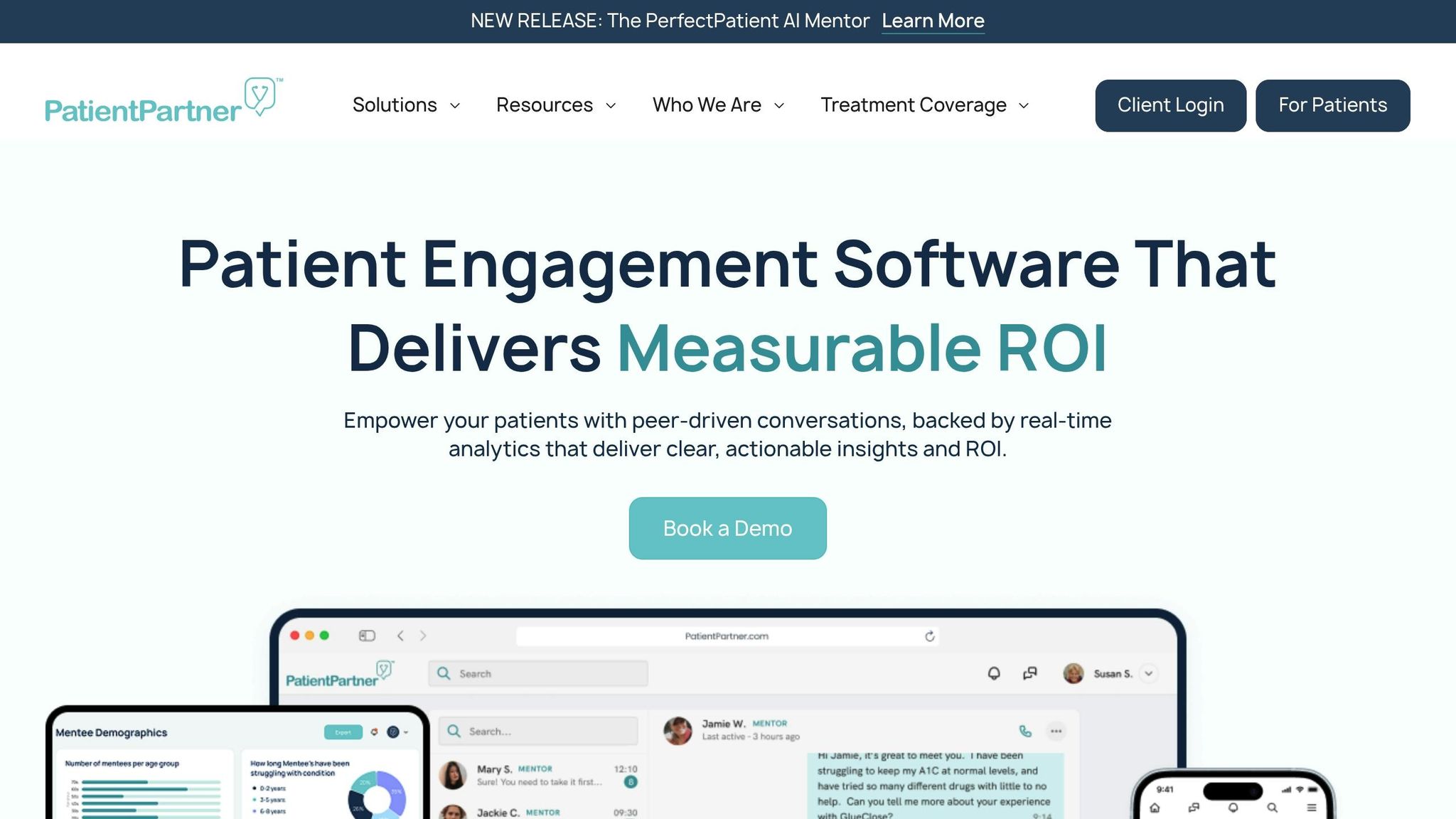How AI Personalization Improves Patient Adherence


Key Takeaways
How AI Personalization Improves Patient Adherence
AI is transforming how patients stick to their treatment plans. By personalizing support using real-time data, predictive analytics, and tailored communication, it addresses the unique challenges each patient faces. This approach ensures better engagement, fewer missed doses, and improved health outcomes. Here’s what you need to know:
- Why non-adherence is a problem: Patients often stop treatments due to side effects, complex schedules, or forgetfulness, leading to worse health outcomes and higher healthcare costs.
- How AI helps: AI identifies at-risk patients early, customizes communication (e.g., reminders via text or calls), and adjusts strategies based on real-time data like prescription records or wearable feedback.
- Human touch matters too: Mentorship programs like PatientPartner pair patients with mentors who provide emotional support and practical advice, complementing AI’s precision.
- Measuring success: Metrics like adherence rates, patient satisfaction, and clinical outcomes show how AI-driven personalization outperforms generic approaches.
AI-powered tools combined with human mentorship create a smarter, patient-focused approach to adherence, benefiting both patients and pharmaceutical companies.
Improving Medication Adherence with AI Solutions w/ AllazoHealth CEO, William Grambley

Key AI Features That Improve Patient Adherence
AI-driven personalization brings together three essential technologies to create a system that actively supports patients and improves treatment adherence. These features reshape how pharmaceutical companies identify risks, connect with patients, and refine their approaches based on real-world insights.
Using Predictive Analytics to Identify At-Risk Patients
Predictive analytics forms the backbone of AI-powered adherence programs. By analyzing key data points, it identifies patients who are more likely to stop their treatments. The system reviews factors like prescription refill history, demographics, past treatment experiences, and healthcare usage patterns.
It flags warning signs commonly linked to adherence issues. For example, patients who frequently miss prescription refills, those starting on complex treatments, or individuals with a history of switching medications are assigned higher risk scores. Age, socioeconomic status, and the presence of multiple chronic conditions also play a role in these predictions.
This technology enables early identification of at-risk patients, often during the initial stages of therapy, allowing timely interventions. Over time, the predictive models improve as they learn from new data, making their assessments more precise. This ensures resources are directed where they’re needed most, and AI-generated insights help craft personalized communication strategies for each patient.
Creating Tailored Communication Plans
AI excels at customizing communication to suit each patient’s preferences and behaviors. Instead of sending the same message to everyone, it analyzes how individuals respond to different outreach methods and adjusts accordingly.
The system personalizes both the content and delivery method. It considers patient-specific data to decide whether to send a text, app notification, email, or even a phone call. The timing and message content are also customized - someone dealing with side effects might receive supportive resources, while a patient who often forgets doses gets reminders.
Communication frequency is tailored as well. Patients who actively engage with digital tools may get daily updates, while those who prefer less frequent contact receive targeted outreach at intervals that suit them. This approach keeps patients engaged without overwhelming them, striking the right balance for effective communication.
Real-Time Data Integration and Dynamic Adjustments
AI goes beyond static strategies by adapting in real time to a patient’s changing circumstances. Modern platforms pull data from multiple sources to continuously refine their approach, ensuring the support provided evolves with the patient’s needs.
Prescription records, patient feedback, wearable device metrics, and healthcare provider notes all contribute to building a complete, up-to-date profile. For instance, if a patient reports new side effects through a portal, the AI system immediately adjusts its messaging to offer relevant guidance and resources.
This adaptability is especially useful when patients face changes in their health, living situation, or treatment plans. On a broader scale, if multiple patients report similar challenges with a particular medication, the system can proactively provide others on the same treatment with helpful information and tips.
Integration with electronic health records and pharmacy systems adds further context. For example, if a patient misses a prescription refill, the system can differentiate between someone who switched pharmacies and someone who has stopped taking their medication. This continuous feedback loop helps refine the patient experience and improve adherence outcomes over time.
Step-by-Step Guide: Using AI Personalization to Improve Adherence
Using AI to personalize patient care involves a structured process that turns raw data into actionable insights. This approach helps pharmaceutical companies create adherence programs that cater to individual patient needs, ultimately leading to better outcomes.
Collecting and Combining Patient Data
The first step in AI personalization is gathering patient data from various sources. Electronic health records (EHRs) serve as the foundation, offering details like diagnoses, treatment histories, lab results, and physician notes. Pharmacy systems add valuable insights, such as prescription refill dates, patterns of medication use, and any switches between medications - key indicators of adherence behavior.
Patient-generated data adds another layer of understanding. Mobile health apps can track medication reminders, log symptoms, and document side effects. Wearables contribute metrics like activity levels, sleep patterns, and vital signs, all of which can correlate with how well a treatment is working. Patient portals provide direct feedback about treatment challenges, adherence barriers, and overall quality of life.
Insurance claims data sheds light on healthcare usage patterns, including emergency visits and specialist consultations, which can reflect treatment success or challenges. Additional insights come from patient surveys, call center interactions, and participation in support programs.
Once the data is collected, it’s consolidated into unified patient profiles. AI platforms standardize data formats, resolve duplicates, and fill in gaps with predictive modeling. This creates a holistic view of each patient, allowing the system to identify trends and patterns that might go unnoticed when data is analyzed in isolation.
To ensure accuracy and compliance with privacy regulations, automated validation checks and regular audits are essential. With these unified profiles in place, patients can then be categorized based on their risk levels, enabling more targeted interventions.
Categorizing Patients by Risk Level
AI algorithms sort patients into risk categories based on their likelihood of discontinuing treatment. These categories allow for tailored strategies that address each group’s specific needs:
- High-risk patients often exhibit warning signs like frequent gaps in prescriptions, switching medications, or experiencing severe side effects. They may also face challenges like complex treatment plans, limited access to healthcare, or financial barriers.
- Medium-risk patients show some concerning behaviors, such as occasionally missing refills or reporting mild side effects. While their overall adherence is stable, they benefit from targeted support to prevent further decline.
- Low-risk patients generally stick to their treatment plans, engage actively with healthcare providers, and report positive experiences. However, they still require monitoring since changes in life circumstances or treatments can alter their risk status.
AI systems assign dynamic risk scores that update as new data comes in. For instance, a patient who consistently refills prescriptions but suddenly reports severe side effects will see their risk score rise, prompting immediate intervention. Conversely, someone showing improved adherence through support programs may shift to a lower risk category.
Each risk group receives customized engagement strategies. For example, high-risk patients might need daily check-ins, priority access to healthcare providers, and detailed educational resources. Medium-risk patients could benefit from weekly follow-ups and content tailored to their specific concerns. Low-risk patients might receive monthly updates and proactive notifications about potential treatment enhancements. This segmentation ensures that follow-up strategies are both precise and effective.
Setting Up Automated Outreach and Monitoring
Automated systems play a key role in delivering personalized interventions. Communication is tailored to patient preferences, whether through SMS, email, or phone calls, and is timed to suit individual habits - morning reminders for some, evening check-ins for others. The system tracks engagement and adjusts outreach timing to maximize response rates.
Personalization goes beyond addressing patients by name. Messages incorporate specific details, such as the medications they’re taking, any side effects they’ve reported, and educational resources relevant to their situation. For example, a patient struggling with injection anxiety might receive instructional videos and success stories from peers, while someone worried about drug interactions could get detailed safety information and pharmacist contact details.
These automated interventions are designed to adapt to patient needs. If a patient stops responding, reports severe side effects, or indicates they might discontinue treatment, the system escalates the issue to healthcare providers or support specialists for immediate follow-up.
Continuous monitoring ensures the system remains responsive. Metrics like engagement rates, adherence improvements, and patient satisfaction scores help refine the AI’s strategies over time. For instance, patients who engage well with educational content may receive more in-depth materials, while those who prefer concise messages get streamlined updates.
The system also acts proactively. If prescription data indicates a missed refill, it triggers targeted outreach to understand the issue and offer support. This real-time responsiveness helps prevent temporary lapses from snowballing into long-term treatment discontinuation.
sbb-itb-8f61039
Real-Time Patient Mentorship: Adding Human Support to AI-Driven Adherence
AI can predict patient behavior with impressive accuracy, but it falls short when it comes to addressing the emotional and psychological hurdles patients face. That’s where real-time patient mentorship steps in, bridging the gap between cold data and the warmth of human connection. This combination creates a more effective strategy for improving adherence to treatments.
How Patient Mentorship Enhances Adherence
Patient mentorship tackles the emotional and practical challenges that AI simply cannot. Fear, anxiety, and uncertainty about starting a new therapy often lead patients to delay or even abandon treatment. A mentor who has been through a similar journey can offer the kind of reassurance and practical advice that algorithms can’t provide.
The kind of support mentors offer often depends on the treatment. For patients starting complex therapies like injections, mentors can teach proper techniques, share tips for managing side effects, and provide encouragement during the adjustment period. For patients preparing for surgery, mentors can set realistic expectations about recovery, discuss pain management, and help them navigate lifestyle changes.
The trust that develops between a patient and their mentor is a key factor in adherence. Patients often see mentors as allies - someone who truly understands what they’re going through. This trust fosters open communication, making it easier for patients to voice concerns and stay committed to their treatment plans.
Mentorship also complements AI tools by providing immediate, human-centered support. For example, when patients face unexpected side effects or logistical issues like insurance problems, mentors can step in with timely advice. This human touch ensures that small challenges don’t spiral into major obstacles, working hand-in-hand with AI to improve adherence.
How PatientPartner Elevates AI Personalization

PatientPartner takes AI-driven adherence to the next level by pairing patients with mentors based on shared characteristics and emotional insights, creating a foundation of trust.
The platform uses sentiment analytics to analyze mentor–patient interactions and uncover emotional triggers, barriers to adherence, and areas where additional support is needed. These insights go beyond what traditional data can provide, feeding back into AI systems to refine and personalize interventions even further.
PatientPartner’s ambassador programs integrate seamlessly with existing AI tools. When high-risk patients are flagged, the platform quickly connects them with mentors who have successfully navigated similar challenges. This reduces delays often seen with traditional support systems.
Additionally, PatientPartner ensures that all interactions comply with healthcare privacy and security standards. This allows pharmaceutical companies to gain valuable insights while staying within regulatory boundaries. By combining human mentorship with AI, the platform creates scalable solutions that support patients over the long haul.
Scalable SaaS Solutions for Sustained Adherence
PatientPartner’s scalable SaaS platform is designed to handle a growing number of mentor–patient relationships without losing the personal touch. It integrates with pharmaceutical systems to provide mentorship programs that expand alongside patient populations.
The platform adapts to different therapeutic areas and patient needs. For chronic conditions requiring long-term adherence, mentors offer ongoing support that evolves as circumstances change. For treatments with shorter timelines, mentors focus on providing intensive guidance during the critical early stages when adherence habits are formed.
PatientPartner’s data integration capabilities allow it to work seamlessly with AI tools, creating a comprehensive picture of patient needs. The platform can process risk scores, match patients with the right mentors, and use feedback from interactions to fine-tune AI strategies.
With enterprise-ready features, PatientPartner ensures smooth integration with existing systems while maintaining brand consistency and meeting compliance standards. This flexibility makes it easy for mentorship programs to align with broader patient support initiatives.
Sustained adherence relies on more than just starting a treatment - it requires continuous engagement. PatientPartner’s mentor network offers adaptable, long-term support that evolves with patients’ changing needs. By combining mentorship with AI-driven personalization, the platform lays a strong foundation for ongoing therapeutic success.
Measuring Results: How to Evaluate AI Personalization Impact on Adherence
Measuring the success of AI-driven personalization in healthcare goes beyond simply checking if patients are taking their medications. The real goal is to understand how personalized strategies influence behavior and improve long-term health outcomes. For pharmaceutical companies, this means defining clear, measurable metrics to assess the effectiveness of these AI tools and justify their investment.
Key Metrics for Tracking Success
When evaluating AI's impact on adherence, these metrics can provide valuable insights:
- Primary adherence rates: This metric tracks the percentage of patients who fill their first prescription. AI personalization plays a key role here by identifying and addressing barriers before patients even leave the doctor’s office.
- Medication possession ratio (MPR): MPR measures long-term adherence by dividing the number of days a patient has their medication by the total days in a treatment period. A high MPR indicates steady adherence. AI can help maintain these levels by predicting potential refill gaps and enabling timely interventions.
- Time to treatment initiation: This measures how quickly patients start treatment after diagnosis. AI tools can shorten this timeline by addressing concerns and connecting patients to resources, ultimately supporting better adherence and clinical outcomes.
- Patient satisfaction scores: These scores reflect how well personalization efforts align with patient needs. AI systems that provide tailored, timely communications - rather than generic reminders - tend to boost satisfaction, which often translates to better adherence.
- Clinical outcome improvements: Metrics like reduced hospitalizations, better lab results, or slower disease progression show how well the program is working. AI-driven personalization aims to support these outcomes by helping patients stick to their treatment plans.
- Cost per adherent patient: This measures the efficiency of AI investments by comparing program costs to the number of patients who remain adherent.
These metrics create a baseline for comparing traditional methods with AI-driven approaches, as summarized in the table below.
Comparing Standard vs. AI-Driven Methods
| Metric | Standard Methods | AI-Driven Personalization |
|---|---|---|
| Response Rate to Outreach | Typically lower response rates | Noticeably higher response rates |
| Time to Identify At-Risk Patients | Identification can take significant time | Near real-time identification |
| Personalization Level | Basic demographic segmentation | Highly customized based on behavioral data |
| Intervention Timing | Reactive - after a missed dose | Predictive - addresses issues proactively |
| Resource Efficiency | Requires significant manual effort | Automated with strategic human oversight |
| Scalability | Limited by staff capacity | Easily scales with larger patient volumes |
Traditional adherence programs often rely on broad segmentation and fixed communication schedules, which may miss key individual factors. AI-driven systems, on the other hand, analyze a wide range of data to deliver personalized interventions precisely when they’re needed. This not only improves patient engagement but also frees up staff to focus on high-priority tasks like complex patient support and program advancement.
Continuous Improvement Through Patient Data
AI systems thrive on continuous learning. By leveraging patient feedback and real-time data, they can refine personalization strategies over time. Unlike static, rule-based systems, AI adapts dynamically to changing needs.
Patient feedback serves as a critical tool in this process. For example, if a specific type of message or communication channel leads to positive engagement, the system learns to replicate that approach for similar patients. On the flip side, limited or negative responses prompt adjustments to improve future interactions.
A/B testing is another powerful method. By experimenting with different message timings or communication styles, teams can identify what works best and feed those insights back into the system for optimization.
AI systems also integrate clinical outcomes data to confirm that improved adherence leads to better health results. This helps pinpoint the interventions that deliver the most meaningful impact.
Regular review cycles are essential for keeping AI systems effective. Combining quantitative metrics with qualitative feedback ensures the models stay accurate and relevant as patient needs and treatment options evolve.
Throughout this process, patient privacy remains a top priority. All data analyses must comply with HIPAA and other regulations, using anonymization and aggregation techniques to safeguard individual information while still extracting valuable insights.
Conclusion: Using AI Personalization for Better Patient Outcomes
AI-powered personalization is reshaping how we approach patient adherence. Instead of relying on one-size-fits-all outreach, these systems use predictive analytics to identify risks, craft tailored messages, and deliver interventions that adapt to individual needs. By anticipating challenges before they arise, AI shifts patient support from being reactive to becoming a proactive, preventive solution.
But technology alone can't address every aspect of patient care. Emotional and psychological challenges require a human touch, and that's where PatientPartner steps in. By combining AI's precision with real-time mentorship, PatientPartner connects patients to mentors who have firsthand experience with similar treatment journeys. This blend of technology and human connection ensures that patients receive both data-driven insights and empathetic guidance.
PatientPartner's scalable SaaS platform is designed to maintain this personal approach, even at scale. Its compliance-ready infrastructure and patient sentiment analytics ensure that mentorship remains effective while leveraging AI to enhance efficiency and predict outcomes. The platform creates a balance - using AI to streamline processes without losing the personal touch that's critical for long-term adherence.
As AI systems continue to learn from each interaction, their ability to personalize interventions becomes even sharper. This feedback loop leads to more precise targeting, better patient outcomes, and a deeper understanding of adherence challenges, setting the stage for continuous improvement.
For pharmaceutical companies looking to revolutionize their adherence strategies, the answer lies in integrating AI-driven tools with human mentorship. This combination lays a strong foundation for lasting therapeutic success, helping patients achieve better health outcomes while supporting the industry's long-term goals.
FAQs
How does AI personalization help patients stay on track with their medications?
AI-powered personalization helps patients maintain their medication routines by offering tailored reminders, monitoring their medication patterns, and delivering emotional support through virtual tools. These features work together to gently encourage patients to take their medications on time and stick to their prescribed schedules.
What sets AI apart is its ability to adapt to each person’s unique needs. For example, it can adjust reminder times to fit a patient’s daily habits or identify trends in missed doses. This kind of proactive support goes beyond simple reminders - it addresses forgetfulness while promoting consistent adherence, ultimately contributing to improved health outcomes.
How does AI-driven patient mentorship improve treatment adherence?
AI-driven patient mentorship is reshaping how individuals stay committed to their treatment plans by delivering real-time, personalized support that aligns with each patient’s unique needs. By blending cutting-edge AI technology with human mentorship, this approach helps patients feel more confident, resolve their concerns, and stay actively involved in their healthcare journey.
For example, platforms like PatientPartner leverage AI to offer timely check-ins, set clear goals, and maintain open lines of communication. This consistent support makes it easier for patients to follow through with their treatments, promoting better adherence and contributing to improved long-term health outcomes.
What metrics are used to measure the success of AI in improving patient adherence, and how do they differ from traditional methods?
AI-powered personalization tools are assessed using important metrics like adherence rates - the percentage of patients sticking to their prescribed treatments - and absolute improvements in adherence, which research shows can rise between 6.7% and 32.7%. These tools also leverage real-time monitoring and predictive analytics, enabling quicker and more precise identification of non-adherence.
On the other hand, traditional methods often depend on less reliable approaches, such as self-reported data or pharmacy refill records, which can be slower to uncover issues. With the advanced metrics provided by AI, healthcare providers can deliver more precise interventions, ultimately enhancing patient outcomes and supporting sustained adherence.
Author

Co-Founder and CEO of PatientPartner, a health technology platform that is creating a new type of patient experience for those going through surgery
Related Articles
Stay Ahead in Patient Engagement
We and selected third parties use cookies or similar technologies for technical purposes and, with your consent, for other purposes as specified in the cookie policy. Use the “Accept” button or close this notice to consent.
We and selected third parties use cookies or similar technologies for technical purposes and, with your consent, for other purposes as specified in the cookie policy. Use the “Accept” button or close this notice to consent.






